In this post, we will discuss the difference between Active and Passive components. We can differentiate active & passive components on the basis of the nature of source & power gain. We can categorize active and passive components, considering various functionality of the components. The various parameters are as follows.
- Component function
- Flow of electron
- Nature of operation
- Nature of source
- Power gain
- Nature of energy
The major difference between active and passive elements is that an active component has the capability of supplying energy, while an active component can not supply the energy.
We widely use active components and passive components in an electric circuit. The components like a capacitor, inductor, resistor, diode, transistor, MOSFET, SCR are the basic building block of an electrical network or electronic circuit.
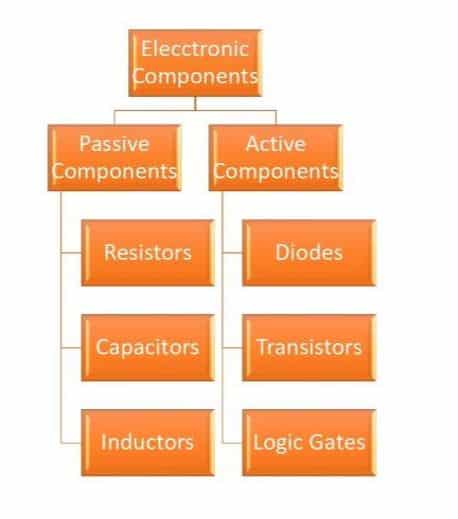
Let us first understand what is active and passive components.
Active Component
The active components are those components that require an external power source for their operation. Without external power to active devices, the active devices can not function. The majority of the active devices are semiconductor devices. The active devices are able to control the flow of electrons through it if the active devices get proper biasing by an external power source. Thus, it is possible to use active devices for signal amplification.
Examples of Active Components
The examples of the active devices are almost all the semiconductor devices. The devices are;
- Bipolar Junction Transistor (BJT)
- Field Effect Transistor (FET)
- Metal Oxide Field Effect Transistor ( MOSFET)
- Silicon Control Rectifier (SCR)
- TRIAC
- Unijunction Transistor (UJT)
- Diodes, Zener Diodes, Tunnel diode, Photo Diode, Schottkey Diode and LED
- Integrated Circuits (ICs)
- Application Specific Integrated Circuits(ASICs)
- Battery
- Voltage and Current Source
Let us understand why the above-given devices fall under the category of active components.
Active Component- Bipolar Junction Transistor (BJT)
We can use a transistor as a switch and as an amplifier. The small DC voltage controls the base current, and it leads to an increase of collector current according to the current gain of the transistor((IC =β IB). Where β is the current gain of the transistor. The below circuit shows how the transistor functions as an amplifier.
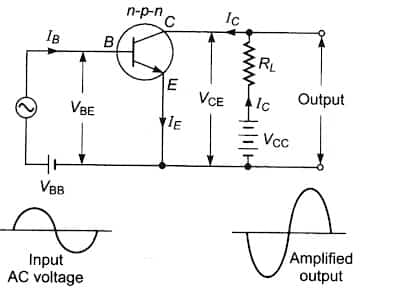
VCC and VBB is the supply voltage for the collector and base of the transistor. The transistor gets proper biasing at the base terminal in order to flow of base current. The small base current adds to the main signal current, and thus we get an amplified signal at the collector.
From the above explanation, it is lucid that without external DC voltage the transistor can not function. That is why the transistor is an active component.
Active Component- Silicon Controlled Rectifier (SCR)
We use a Silicon-controlled rectifier (SCR) as a switch & AC voltage controller. By changing the firing angle the voltage is controlled. The SCR is widely used in DC drive, soft starter applications. Thus, the SCR functions only if it gets a trigger pulse at its gate terminal.
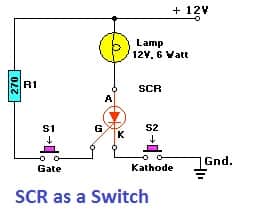
It is clear that SCR functions on the application of an external power source at its gate terminal, therefore SCR is an active component.
The external voltage applied to the gate terminal of the SCR makes it ideal for the voltage regulator. The SCR can be fired at a particular instant of the AC waveform and accordingly output voltage is governed. The circuit diagram is as shown below.
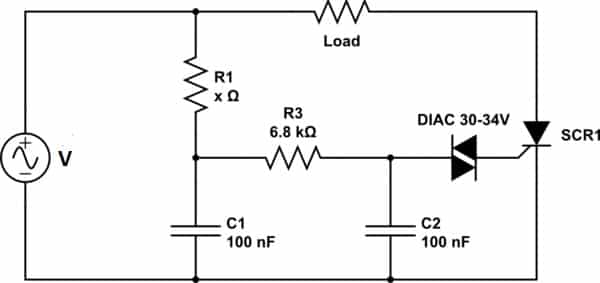
Active Component- Metal Oxide Field Effect Transistor(MOSFET)
MOSFET is widely used as a switch and as an amplifier. MOSFET is a three-terminal semiconductor device. It has a gate, drain, and source terminal. The voltage applied at the gate terminal makes the MOSFET in a conduction state. The external DC voltage at the gate terminal is responsible for the conduction of MOSFET. Therefore, MOSFET is an active component. The circuit diagram of MOSFET as an amplifier is given below.
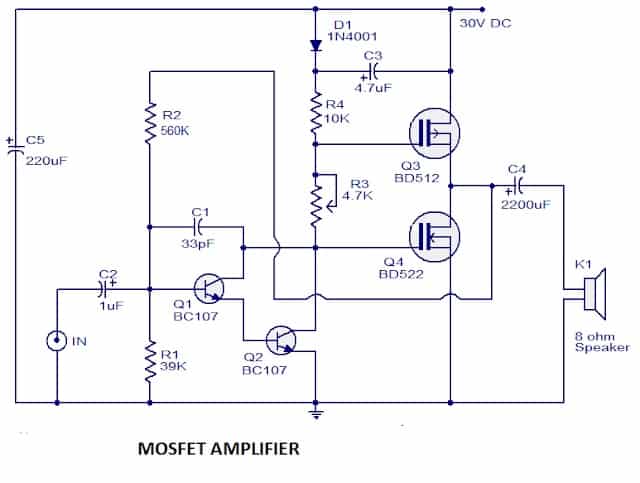
Active Component- Voltage Source
A voltage source is an example of an active component. A voltage source supplies energy to the circuit. The battery supplies energy to the electric circuit, therefore it is an active component.
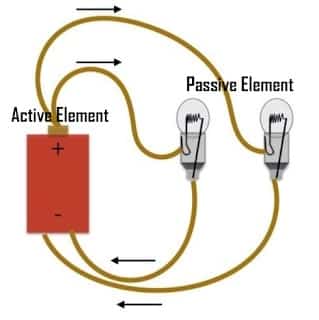
Active Component- Current Source
A current source also falls in the category of the active component. The current supplied by an ideal current source does not depend on the circuit voltage. A current source controls the flow of electric charge in a circuit. Therefore, the current source is an active component. A voltage source supplies energy to the circuit. The battery supplies energy to the electric circuit, therefore it is an active component.
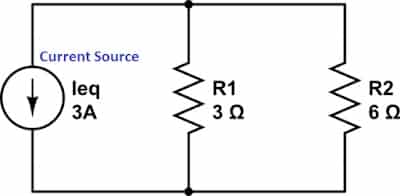
Passive component
Passive components can not control the flow of electric charge through it. It either dissipates, absorbs, or stores the electric or magnetic field. A passive component does not require any external power source for its operation. Therefore, the passive devices can not amplify, oscillate or provide power gain.
Examples of Passive Components
The followings components are passive components.
- Resistor
- Capacitor
- Inductor
- Transformer
We can divide the passive components into two categories.
- Lossy or Dissipative: These devices can not absorb the electric power, rather these devices dissipate the power through it. Resistor is the example of lossy or dissipative passive component.
- Lossless: These devices store the electrical energy. The examples of lossless passive devices are inductor, capacitor and transformer.
Most of the passive components are two-terminal devices and are referred to as a two-port terminal.
Passive Component- Resistor
A resistor as its name implies resist the flow of electron. The resistor receives the energy from the source and it dissipates the energy as heat during the flow of electric current through it. The resistor is a passive component because it does not amplify the power, rather it dissipates the power.
The amount of opposition to the flow of electric charge is what we call resistance. We denote it by the symbol “R”. The resistor follows Ohm’s law. The power dissipated by the resistor is equal to I2R. Where I is the current and R is the resistance of the circuit. The carbon film, metal film, wire wound, and adjustable resistors are the main types of resistors we use in an electrical circuit.
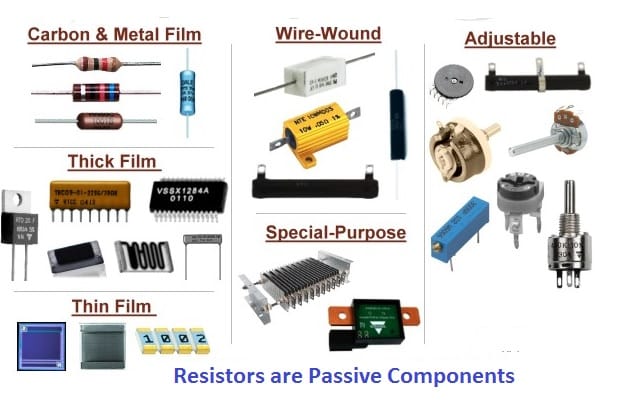
Inductor
The inductor resists the change in the current of the circuit. The inductor does not dissipate the energy; it stores energy in its magnetic field and later it delivers the energy, but not on a continuous basis.
The energy stored by an inductor in its magnetic field is equal to 1/2 L* I2. Where L is the inductance of the inductor and I is the current flowing through it. The energy absorption and its deliverance is transient in nature, and it depends on the time constant of the circuit. That is why the inductor is a passive component. The inductor has a very high impedance on AC and a very low impedance on DC. The inductors are widely used in power supply, SMPS, and AC/DC converters.
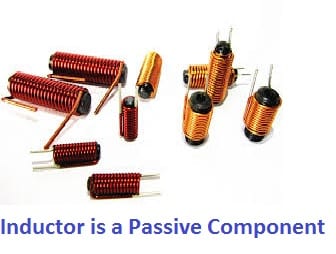
Passive Component- Capacitor
A capacitor stores the energy in its electric field. That is why a capacitor is a passive component. The capacitor stores the energy and later on it deliver the same, but not continuously. The capacitor is used in an electronic circuit, and it is also used for power factor improvement. The energy stored by a capacitor in its electric field is equal to 1/2 C* V2. Where C is the capacitance of the capacitor and V is the voltage applied across it.
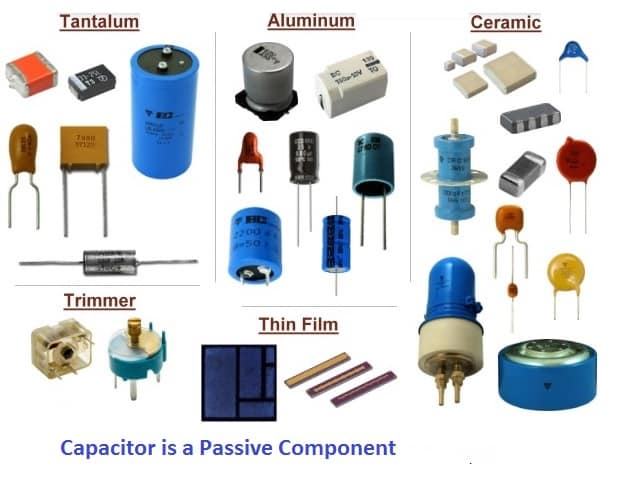
Transformer
The transformer is a piece of static electrical equipment that transfers the electric power from the primary side to the secondary side without changing the frequency. The transformer simply transfers the energy, and that is why it is a passive component.
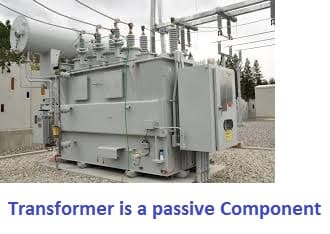
Key differences between active and passive component
- Active components require an extra power for its operation, whereas , the passive components do not require extra power for its operation.
- Active component produce energy in the form of voltage or current. Passive component stores, transfer and utilize the energy. The inductor and capacitor store the energy in the magnetic and electric field respectively, and transformer transfers the energy from primary side to secondary side.
- Active components are non linear devices. The current does not vary in the proportion of the increase in voltage. The active devices does not obey the Ohm’s law. Passive components are linear devices, and current through these devices increases with increase in the applied voltage, thus these devices follow the Ohm’s law.
- Active components have capability to provide power gain, whereas the passive components can not provide power gain.
- Active components can control the flow of electron or electric current. The passive components can not control the flow of electric current passing through it.
- Active components are energy donor, whereas passive components are energy acceptor.
Read Next:
1 thought on “Difference between Active and Passive Components”